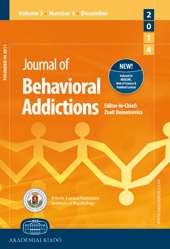Gambling disorders, gambling type preferences, and psychiatric comorbidity among the Thai general population: Results of the 2013 National Mental Health Survey
Gambling disorders, gambling type preferences, and psychiatric comorbidity among the Thai general population: Results of the 2013 National Mental Health Survey
Author(s): Sawitri Assanangkornchai, Edward B. McNeil, Nopporn Tantirangsee, Phunnapa KittirattanapaiboonSubject(s): Cognitive Psychology, Behaviorism, Psychoanalysis, Substance abuse and addiction
Published by: Akadémiai Kiadó
Keywords: pathological gambling; problem gambling; psychiatric comorbidity; gambling type preference; National Mental Health Survey;
Summary/Abstract: To estimate the prevalence of problem and pathological gambling, gender and age-group differences in gambling types, and comorbidities with other psychiatric disorders among the Thai general population. Methods: Analysis was conducted on 4,727 participants of Thailand’s 2013 National Mental Health Survey, a multistage stratified cluster survey, using the Composite International Diagnostic Interview. Diagnoses of problem and pathological gambling and other psychiatric disorders were based on the DSM-IV-TR criteria with the following additional criteria for gamblers: more than 10 lifetime gambling episodes and a single year loss of at least 365 USD from gambling. Results: The estimated lifetime prevalence rates of pathological and problem gambling were 0.90% [95% confidence interval (CI): 0.51–1.29] and 1.14% (95% CI: 0.58–1.70), respectively. The most popular type of gambling was playing lotteries [69.5%, standard error (SE) = 1.9], the prevalence of which was significantly higher among females and older age groups. The most common psychiatric disorders seen among pathological gamblers were alcohol abuse (57.4%), nicotine dependence (49.5%), and any drug use disorder (16.2%). Pathological gambling was highly prevalent among those who ever experienced major depressive episodes (5.5%), any drug dependence (5.1%), and intermittent explosive disorder (4.8%). The association between pathological gambling was strongest with a history of major depressive episode [adjusted odds ratio (AOR) = 10.4, 95% CI: 2.80–38.4]. Conclusion: The study confirms the recognition of gambling disorders as a public health concern in Thailand and suggests a need for culturally specific preventive measures for pathological gamblers and those with a history of substance use disorders or major depression.
Journal: Journal of Behavioral Addictions
- Issue Year: 5/2016
- Issue No: 3
- Page Range: 410-418
- Page Count: 9
- Language: English

